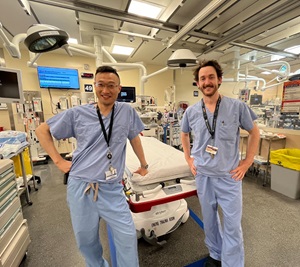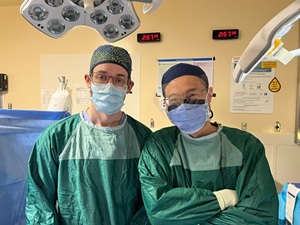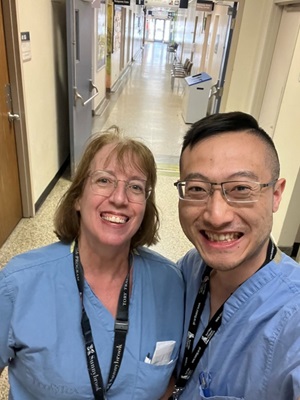2024 | Volume 25 | Issue 4
Author: Dr Victor Kong, MD, PhD, ChM, MSc, DRCPSC, MRCS, FRACS - Trauma surgeon

Trauma Bay: Dr Kong and Dr Brent Hopkins
Introduction
The completion of overseas Fellowship training is an important milestone in the career development of a trauma surgeon. It provides a unique opportunity to understand how other trauma systems function. Ultimately, the relevant lessons and experience gained can bring distinctive insights that serve to improve and strengthen the trauma system in Aotearoa New Zealand.
I was determined to pursue an international trauma Fellowship in one of the largest trauma programs in Canada—the Tory Trauma Program at Sunnybrook Health Science Centre (SHSC) in Toronto.
Background
I have had a passion for trauma surgery for as long as I can recall. The journey I have undertaken to complete my surgical training has been far from ‘standard’, as I have trained in the United Kingdom, Ireland, Australia and Aotearoa New Zealand. I also spent four years in South Africa, focusing exclusively on trauma surgery. After I returned to Aotearoa New Zealand and completed my FRACS, I was accepted on the Post Fellowship Education Training Programme (PFET) in trauma surgery and completed the two-year Australia and New Zealand Association for the Surgery of Trauma (ANZAST) Fellowships program. The international trauma Fellowship at Sunnybrook
Hospital was the next logical step as I felt that gaining additional experience in a high-volume centre in a North American setting would enable me to further develop my expertise in trauma care.
The Tory Trauma Program
SHSC is in East York, Toronto and was the first and is the largest trauma centre in Canada. It is also an American College of Surgeons (ACS) verified Level 1 trauma centre. It provides quaternary care for a catchment population of more than eight million and is a major referral site for Northern Ontario. It has approximately 2000 trauma team activations per year.
The trauma service model
Clinical service delivery is based on a ‘trauma surgeon of the week model’, where one consultant trauma surgeon (known as a staff or attending surgeon) is responsible for the clinical care for the week. They are supported by two trauma Fellows, various general surgery registrars (known as residents) and regular ‘rotating residents’ (mostly working in family medicine, emergency medicine or general surgery) from all over Canada. There are several major differences between this and the Aotearoa New Zealand system of training. For instance, there are no official house officer (or intern) grade junior doctors. Most of the ward work is undertaken by residents at various training levels. All non-consultant and non-Fellow junior doctors are collectively known as residents, who are broadly equivalent to registrars. Every resident is in training and there are no ‘non-training’ residents.
Trauma team leader role
One of the unique aspects of the Fellowship is the specific role of a trauma team leader (TTL), who could be a trauma surgeon (or their Fellow), anaesthetist or emergency physician. The primary responsibility of the TTL is to conduct initial resuscitation of the injured patient. This provides each TTL with a unique opportunity to develop their own leadership and decision-making style in a high-pressure environment. The TTL generally dictates all aspects of the initial resuscitation. This includes blood product management, drugs for rapid sequence intubation, and post-intubation sedation. When I assumed this role, I found the nursing staff were phenomenal and extremely helpful. I was, again, rather fortunate as the short stint in my very first Senior House Officer (SHO) job in anaesthetics more than 16 years ago proved to be very useful indeed!
The trauma bay
The trauma bay (also known as the resuscitation room) at SHSC is extremely well organised. I was particularly impressed with the attention to detail paid to every aspect of the trauma bay. Everything is well thought out, including the ergonomics. Coloured lines and markings on the floor help direct where each person stands. There is also a very structured Emergency Medical Service (EMS) handover process to the trauma team. Everything required for any procedure such as an arterial line, central line, or urinary catheter is placed in a single clearly labelled bag.

Dr Kong and Dr Hopkins operating together
Strength of a system
Used as a platform for education, monthly ‘Morbidity and Mortality’ meetings are held at which Fellows present cases. These are well attended by colleagues from other specialties. One unique aspect of quality improvement is the trauma team video review (TTVR). In this session, a case containing an educational component thought to be of value to the wider trauma team is selected and presented, with a staff trauma surgeon acting as facilitator. I personally found this refreshing and view it as an effective way of understanding team dynamics and decision-making.
Final thoughts
Toronto is the fourth largest city in North America and one of the most ethnically diverse cities in Canada. I have had opportunities to meet people from many parts of the world and from all walks of life. I have learnt much about the Canadian culture, forged collegial relationships and developed friendships along the way. I was delighted to be given the opportunity to continue to expand my horizons in trauma care. I will always be proud to have graduated from the Sunnybrook trauma Fellowship program. Although the Canadian winter can be rather cold, I heeded the advice from my Canadian colleagues–all you need is a good jacket (Canda Goose brand) and a good pair of winter snow boots. So, it proved, and I did just fine!

Dr Lorraine Tremblay, trauma surgeon, with Dr Kong